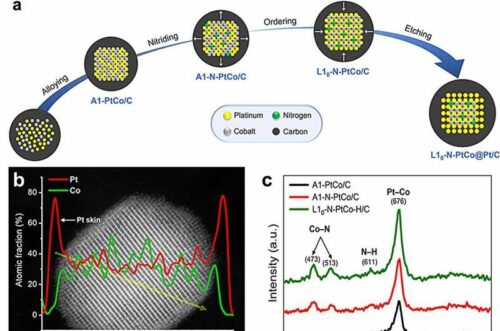The nitrogen-doped alloy makes fuel cells last longer, cost less, and helps hydrogen fuel cells become more widely used in cars, ships, planes, and power plants.

A research team from Daegu Gyeongbuk Institute of Science and Technology (DGIST) has achieved a significant breakthrough in alloy catalyst technology, addressing critical fuel cell durability and cost challenges. By incorporating nitrogen into the alloy structure, the team tackled the high expense and low durability of platinum (Pt) catalysts—key barriers to commercializing proton exchange membrane fuel cells (PEMFC) for environmentally friendly vehicles.
As global efforts to advance hydrogen fuel cell commercialization intensify, researchers are working to resolve technical hurdles. Among the promising solutions, platinum-cobalt (PtCo) alloys have shown remarkable performance but suffer from durability issues, mainly due to the rapid dissolution of cobalt and their high cost.
To overcome these limitations, the team at DGIST developed a pioneering synthesis method that introduces nitrogen into PtCo alloys. This nitrogen-doping technique enhances alloy durability by forming stable cobalt-nitrogen bonds, preventing cobalt dissolution. The innovation significantly reduces the platinum requirement while maintaining superior performance and stability, marking a major step toward commercializing low-platinum, high-durability fuel cells.
The newly developed nitrogen-doped PtCo alloy stands out for its highly ordered PtCo structures, both on its surface and within its core, and its remarkable structural stability, achieved through cobalt–nitrogen bonding. Computational chemical analysis by Professor Seoin Baek of Sogang University demonstrated that the robust cobalt–nitrogen bond doubles the dissolution energy of cobalt, substantially improving its stability within the alloy.
The development of platinum-cobalt alloys with exceptional initial performance has led to a technology that addresses the dual requirements of longevity and efficiency in hydrogen fuel cells. This advancement is expected to support the widespread adoption of hydrogen fuel cells as a sustainable energy solution across diverse sectors, including automotive, marine, aviation, and power generation.
Reference : Muhammad Irfansyah Maulana et al, Cobalt Nitride-Implanted PtCo Intermetallic Nanocatalysts for Ultrahigh Fuel Cell Cathode Performance, Journal of the American Chemical Society (2024). DOI: 10.1021/jacs.4c09514









